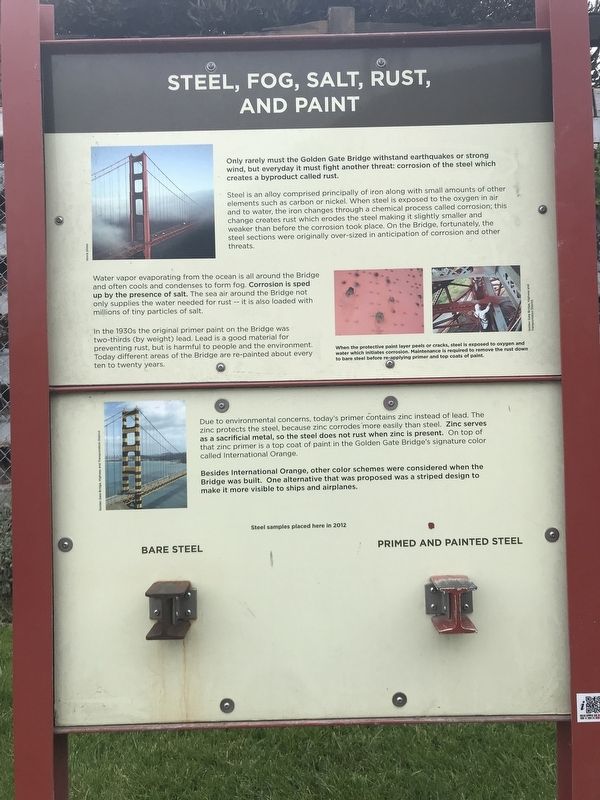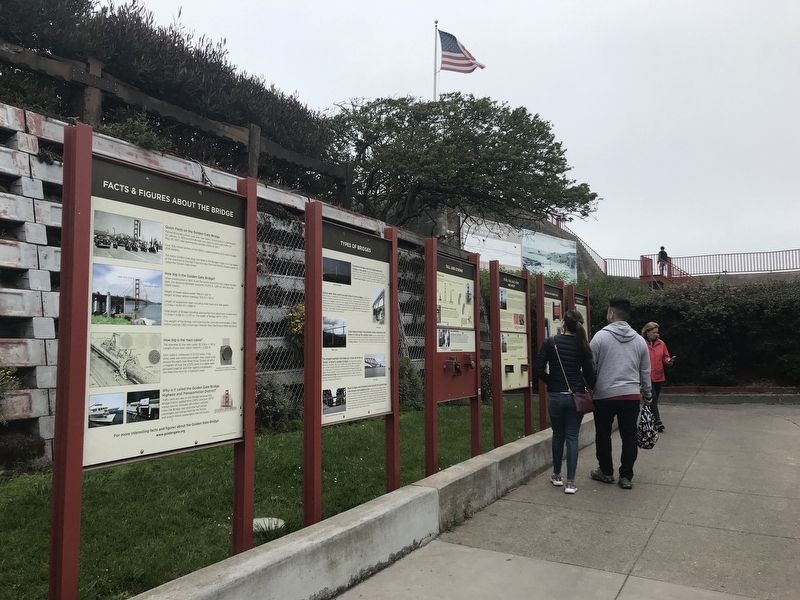Presidio of San Francisco in San Francisco City and County, California — The American West (Pacific Coastal)
Steel, Fog, Salt, Rust, and Paint
Inscription.
Only rarely must the Golden Gate Bridge withstand earthquakes or strong wind, but everyday it must fight another threat: corrosion of the steel which creates a byproduct called rust.
Steel is an alloy comprised principally of iron along with small amounts of other elements such as carbon or nickel. When steel is exposed to the oxygen in air and to water, the iron changes through a chemical process called corrosion; this change creates rust which erodes the steel making it slightly smaller and weaker than before the corrosion took place. On the Bridge, fortunately, the steel sections were originally over-sized in anticipation of corrosion and other threats.
Water vapor evaporating from the ocean is all around the Bridge and often cools and condenses to form fog. Corrosion is sped up by the presence of salt. The sea air around the Bridge not only supplies the water needed for rust -- it is also loaded with millions of tiny particles of salt.
In the 1930s the original primer paint on the Bridge was two-thirds (by weight) lead. Lead is a good material for preventing rust, but is harmful to people and the environment. Today different areas of the Bridge are re-painted about every ten to twenty years.
Due to environmental concerns, today’s primer contains zinc instead of lead. The zinc protects the steel, because zinc corrodes more easily than steel. Zinc serves as a sacrificial metal, so the steel does not rust when zinc is present. On top of that zinc primer is a top coat of paint in the Golden Gate Bridge’s signature color called International Orange.
Besides International Orange, other color schemes were considered when the Bridge was built. One alternative that was proposed was a striped design to make it more visible to ships and airplanes.
Caption: When the protective paint layer peels or cracks, steel is exposed to oxygen and water which initiates corrosion. Maintenance is required to remove the rust down to bare steel before re-applying primer and top coats of paint. Golden Gate Bridge, Highway and Transportation District
Erected 2012 by Golden Gate Bridge, Highway and Transportation District.
Topics. This historical marker is listed in these topic lists: Bridges & Viaducts • Environment. A significant historical year for this entry is 2012.
Location. 37° 48.482′ N, 122° 28.536′ W. Marker is in San Francisco, California, in San Francisco City and County. It is in Presidio of San Francisco. Marker can be reached from Coastal Trail. Marker is at lower-level entrance
at Golden Gate Bridge Vista Point South overlook. Touch for map. Marker is in this post office area: San Francisco CA 94129, United States of America. Touch for directions.
Other nearby markers. At least 8 other markers are within walking distance of this marker. Facts & Figures About the Bridge (here, next to this marker); Tall and Strong (here, next to this marker); Art Deco on a Grand Scale (here, next to this marker); Types of Bridges (here, next to this marker); Battery Lancaster (a few steps from this marker); Joseph Strauss Legacy Circle (a few steps from this marker); Bridging the Gate — the Beginning (a few steps from this marker); Men of Vision (a few steps from this marker). Touch for a list and map of all markers in San Francisco.
Credits. This page was last revised on February 7, 2023. It was originally submitted on July 6, 2021, by Duane and Tracy Marsteller of Murfreesboro, Tennessee. This page has been viewed 186 times since then and 6 times this year. Photos: 1, 2. submitted on July 6, 2021, by Duane and Tracy Marsteller of Murfreesboro, Tennessee.

